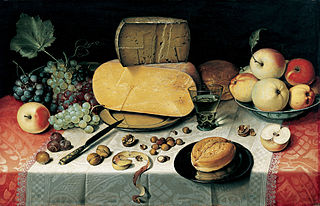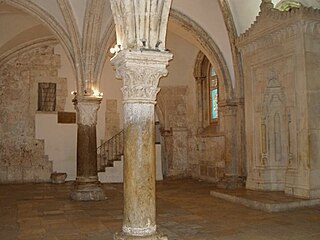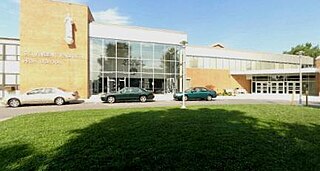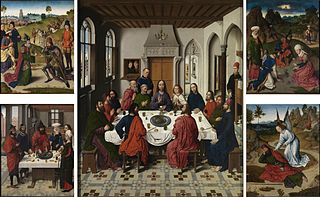Related Research Articles

An abbey is a type of monastery used by members of a religious order under the governance of an abbot or abbess. Abbeys provide a complex of buildings and land for religious activities, work, and housing of Christian monks and nuns.

The Eucharist also known as Holy Communion and the Lord's Supper, among other names, is a Christian rite that is considered a sacrament in most churches, and as an ordinance in others. According to the New Testament, the rite was instituted by Jesus Christ during the Last Supper ; giving his disciples bread and wine during a Passover meal, he commanded them to "do this in memory of me" while referring to the bread as "my body" and the cup of wine as "the blood of my covenant, which is poured out for many".

The Last Supper is the final meal that, in the Gospel accounts, Jesus shared with his apostles in Jerusalem before his crucifixion. The Last Supper is commemorated by Christians especially on Maundy Thursday. The Last Supper provides the scriptural basis for the Eucharist, also known as "Holy Communion" or "The Lord's Supper".

In architecture, a hall is a relatively large space enclosed by a roof and walls. In the Iron Age and early Middle Ages in northern Europe, a mead hall was where a lord and his retainers ate and also slept. Later in the Middle Ages, the great hall was the largest room in castles and large houses, and where the servants usually slept. As more complex house plans developed, the hall remained a large room for dancing and large feasts, often still with servants sleeping there. It was usually immediately inside the main door. In modern British houses, an entrance hall next to the front door remains an indispensable feature, even if it is essentially merely a corridor.

Supper was originally a secondary lighter evening meal. The main meal of the day, called dinner, used to be served closer to what is known as lunchtime, around the middle of the day, but crept later over the centuries, mostly over the course of the 19th century. When dinner was still at the early time, eating a lighter supper in the evening was very common; it was not always the last meal of the day, as there might be a tea later. Reflecting the typical custom of 17th century elites, Louis XIV dined at noon, with a supper at 10pm. Even when dinner was in the early evening, supper was served at, or on return from, a ball, and might be after other evening excursions. At an English ball in 1791, supper was served to 140 guests at 1:00am. They would all have had dinner at home many hours earlier, before coming out. Other, grander, balls served supper even later, up to 3:30 am., at a London ball given in 1811 by the Duchess of Bedford.

Vincent Pallotti was an Italian ecclesiastic and a saint. Born in Rome, he was the founder of the Society of the Catholic Apostolate later to be known as the "Pious Society of Missions". The original name was restored in 1947. He is buried in the church of San Salvatore in Onda. He is considered the forerunner of Catholic Action. His feast day is 22 January.

The Cenacle, also known as the Upper Room, is a room in Mount Zion in Jerusalem, just outside the Old City walls, traditionally held to be the site of the Last Supper, the final meal that, in the Gospel accounts, Jesus held with the apostles.

The Society of the Catholic Apostolate, better known as the Pallottines, are a Society of Apostolic Life within the Roman Catholic Church, founded in 1835 by the Roman priest Saint Vincent Pallotti. Pallottines are part of the Union of Catholic Apostolate and are present in 45 countries on six continents. The Pallottines administer one of the largest churches in the world, the Basilica of Our Lady of Peace of Yamoussoukro in Côte d'Ivoire.

Sacramental union is the Lutheran theological doctrine of the Real Presence of the body and blood of Christ in the Christian Eucharist.

St. Vincent Pallotti High School, usually called Pallotti, is a private school in eastern Laurel, Maryland. It was founded by the Pallottines in 1921 and is within the Roman Catholic Archdiocese of Washington.

Ciudad Vieja is a historic neighbourhood in Montevideo, the capital of Uruguay. Located in a peninsula at the entrance of the natural port of Montevideo it was founded in 1724 as a walled city by the Spanish Empire, after the independence of Uruguay the city rapidly grew outwards and the Ciudad Vieja remained as one of the central neighbourhoods, nowadays it serves as one of the main office districts of Montevideo, housing multiple banks and institutions, but also as one of main tourist attractions in Uruguay due to its historical significance and classical architecture.

A refectory is a dining room, especially in monasteries, boarding schools and academic institutions. One of the places the term is most often used today is in graduate seminaries. The name derives from the Latin reficere "to remake or restore," via Late Latin refectorium, which means "a place one goes to be restored".

Union of Catholic Apostolate is a Catholic association established by a Roman priest St. Vincent Pallotti in 1835.

Church teaching places the origin of the Eucharist in the Last Supper of Jesus with his disciples, at which he is believed to have taken bread and given it to his disciples, telling them to eat of it, because it was his body, and to have taken a cup and given it to his disciples, telling them to drink of it because it was the cup of the covenant in his blood.

St Peter's Italian Church is a Roman Catholic basilica-style church located in Saffron Hill on Clerkenwell Road, Holborn, London. It lies just within the boundaries of the London Borough of Camden, but is particularly associated with the Italian community of Clerkenwell.

Tea has long been used as an umbrella term for several different meals. English writer Isabella Beeton, whose books on home economics were widely read in the 19th century, describes meals of various kinds and provides menus for the "old-fashioned tea", the "at-home tea", the "family tea", and the "high tea".

Palotina is a Brazilian municipality in western Paraná state, located around 60 kilometers from the border with Paraguay.

A sacrament is a Christian rite recognized as of particular importance and significance. There are various views on the existence and meaning of such rites. Many Christians consider the sacraments to be a visible symbol of the reality of God, as well as a channel for God's grace. Many denominations, including the Catholic, Lutheran, Anglican, Methodist, and Reformed, hold to the definition of sacrament formulated by Augustine of Hippo: an outward sign of an inward grace, that has been instituted by Jesus Christ. Sacraments signify God's grace in a way that is outwardly observable to the participant.

Altarpiece of the Holy Sacrament or Triptych of the Last Supper is a 1464–1468 dated triptych attributed to Dieric Bouts, now reassembled and held at its location of origin at St. Peter's Church, Leuven.
References
- 1 2 One or more of the preceding sentences incorporates text from a publication now in the public domain : Chisholm, Hugh, ed. (1911). "Coenaculum". Encyclopædia Britannica . Vol. 6 (11th ed.). Cambridge University Press. p. 644.
- ↑ Proksch, Brigitte (2014). Beteiligung - Vielfalt - Dialog Inspirationen Vinzenz Pallottis zur Ekklesiologie. Friedberg (Bay.). ISBN 978-3-87614-000-1. OCLC 887899298.